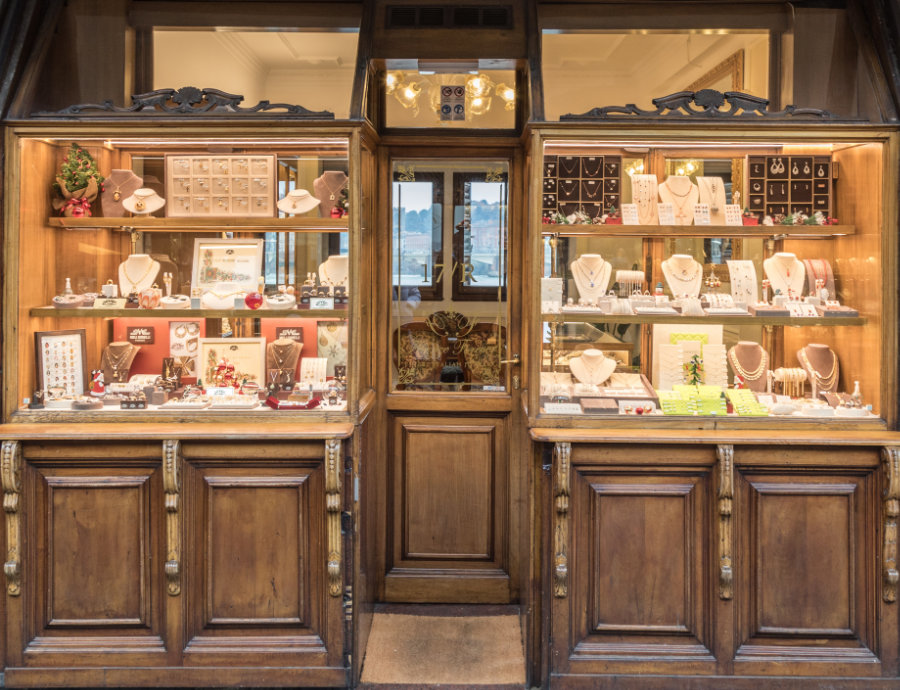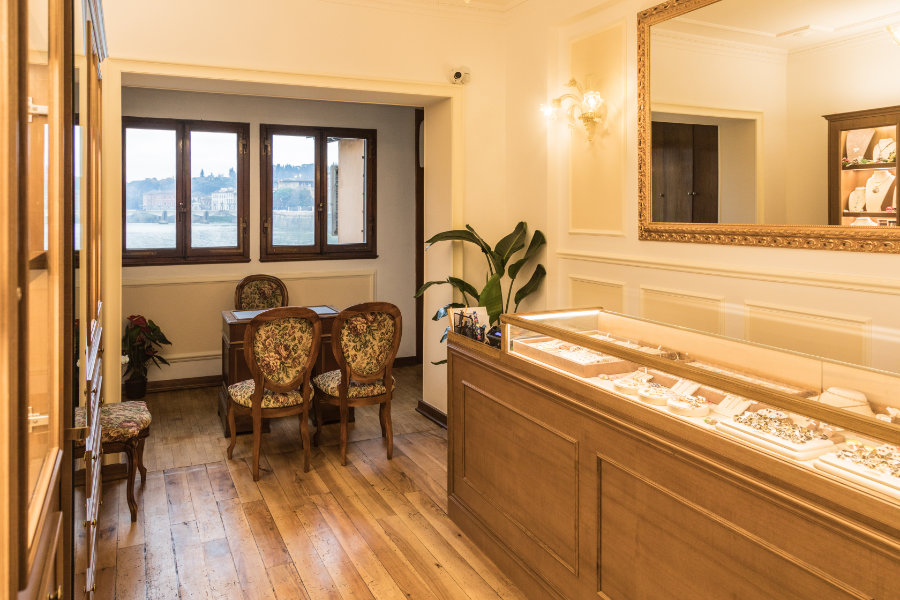Florentine excellence
Firenze Forever, one of a few goldsmith's ateliers located in the heart of the ponte vecchio, which creates and produces handcrafted jewelry as was once done in the renaissance at the time of cellini's welcome.
In our goldsmith's workshop, craft jewelry in only 18 karati and precious stones are made, also on the design and conception of customers, following the traditional processing techniques that have made florentine goldsmith art famous in the world.
Exclusively we present precious illuminated reproductions of art painted entirely by hand, perforated, jumped and ecided jewelry in bulino and refined creations in twisted gold thread and etruscan granulation. we have these proposals, also very current jewelry lines with pure innovative design, which represent the evolution of florentine goldsmith art in a contemporary key.
In the workshop, we also present the best of florentine silver creations: from the famous changes that make florence famous in the world, to the most new gioello ideas, such as the original perfume diffusers, the ecological lines inspired by the world of bees and the objects made with multicolored fire enamel.
Firenze Forever: a long tradition of orafa that is renewed every day offering customers only jewels guaranteed for the perfect workmanship, for the title of the precious metal and the quality of the stones used.


What is MADREVITATO
Madrevitato is a complex gold processing technique that was developed in ancient Etruria, creating masterpieces of jewelry all handmade, as the artisans of Meli do today: small threads of gold are twisted with special tweezers in order to create elegant arabesque shapes (the ornaments), which are embellished with refined spheres of different sizes, completing the design. Unlike the more well-known and common filigree (which instead uses a long gold thread twisted on itself), this process is based on the union of small ornaments, welded together one by one to form jewels of incredible delicacy.
In the jewel welded with the mother screw, spheres of different sizes are then normally added, which are typical of the "Granulation", another very famous technique of working Etruscan gold which consists in creating perfectly spherical granules of different sizes, to be added on the manufactured item welded in order to obtain refined decorative games. Madrevitato and Granulation are goldsmith techniques that are more than 3,000 years old but are still used today in the goldsmith workshops of Firenze Gioielli just as they did in the past, creating fascinating jewels in geometric and traditional shapes.
THE TRAFORO, THE OVERHANG AND THE ENGRAVING
During the Renaissance the city of Florence was at the center of the splendid flowering of the arts, which also produced masterpieces in the jewelery and goldsmith sector, leading to the introduction of a series of techniques that still allow the creation of jewels of extraordinary beauty. and perfection.
First of all the fretwork: once present in all art workshops, while today it is a rare and difficult gold working technique that only a few masters know how to use. Then the overhang, which gives volume and roundness to the forms; finally, the engraving for the final touch, the one that enriches the foliage with veins and everything that you don't want to make appear shiny.
Each Meli jewel is numbered, made entirely by hand and accompanied by a guarantee that certifies the uniqueness and authenticity of the components.
Ponte Vecchio
The bridge spans the Arno at its narrowest point where it is believed that a bridge was first built in Roman times, when the via Cassia crossed the river at this point. The Roman piers were of stone, the superstructure of wood. The bridge first appears in a document of 996 and was destroyed by a flood in 1117 and reconstructed in stone.
In 1218 the Ponte alla Carraia, a wooden structure, was established nearby which led to it being referred to as "Ponte Nuovo" relative to the older (Vecchio) structure. It was swept away again in 1333 except for two of its central piers, as noted by Giovanni Villani in his Nuova Cronica. It was rebuilt in 1345. Giorgio Vasari recorded the traditional view of his day that attributed its design to Taddeo Gaddi — besides Giotto one of the few artistic names of the trecento still recalled two hundred years later. Modern historians present Neri di Fioravanti as a possible candidate as builder. Sheltered in a little loggia at the central opening of the bridge is a weathered dedication stone, which once read Nel trentatrè dopo il mille-trecento, il ponte cadde, per diluvio dell' acque: poi dieci anni, come al Comun piacque, rifatto fu con questo adornamento. The Torre dei Mannelli was built at the southeast corner of the bridge to defend it.
The bridge consists of three segmental arches: the main arch has a span of 30 meters (98 feet) the two side arches each span 27 meters (89 feet). The rise of the arches is between 3.5 and 4.4 meters (11½ to 14½ feet), and the span-to-rise ratio 5:1. The shallow segmental arches, which require fewer piers than the semicircular arch traditionally used by Romans, enabled ease of access and navigation for animal-drawn carts. Another notable design element is the large piazza at the center of the bridge that Leon Battista Alberti described as a prominent ornament in the city.
Damage shown shortly after liberation in August 1944 during World War II
It has always hosted shops and merchants who displayed their goods on tables before their premises, after authorization by the Bargello (a sort of a lord mayor, a magistrate and a police authority). The back shops (retrobotteghe) that may be seen from upriver, were added in the seventeenth century.
During World War II, the Ponte Vecchio was not destroyed by the German army during their retreat at the advance of the British 8th Army on 4 August 1944, unlike all the other bridges in Florence. This was, according to many locals and tour guides, because of an express order by Hitler. Access to the Ponte Vecchio was, however, obstructed by the destruction of the buildings at both ends of the bridge, which have since been rebuilt using a combination of original and modern designs.

